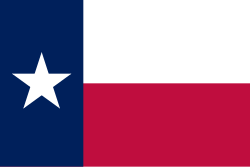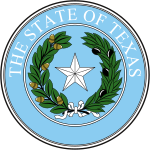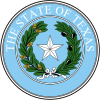Texas theme by eddie g
Download: Texas.p3t

(13 backgrounds)
Texas | |
|---|---|
| Nickname: The Lone Star State | |
| Motto: Friendship | |
| Anthem: "Texas, Our Texas" | |
 Map of the United States with Texas highlighted | |
| Country | United States |
| Before statehood | Republic of Texas |
| Admitted to the Union | December 29, 1845 (28th) |
| Capital | Austin |
| Largest city | Houston |
| Largest county or equivalent | Harris |
| Largest metro and urban areas | Dallas–Fort Worth |
| Government | |
| • Governor | Greg Abbott (R) |
| • Lieutenant Governor | Dan Patrick (R) |
| Legislature | Texas Legislature |
| • Upper house | Senate |
| • Lower house | House of Representatives |
| Judiciary | Supreme Court of Texas (Civil) Texas Court of Criminal Appeals (Criminal) |
| U.S. senators | John Cornyn (R) Ted Cruz (R) |
| U.S. House delegation | 25 Republicans 13 Democrats (list) |
| Area | |
| • Total | 268,596[1] sq mi (695,662 km2) |
| • Land | 261,232[1] sq mi (676,587 km2) |
| • Water | 7,365[1] sq mi (19,075 km2) 2.7% |
| • Rank | 2nd |
| Dimensions | |
| • Length | 801[2] mi (1,289 km) |
| • Width | 773[2] mi (1,244 km) |
| Elevation | 1,700 ft (520 m) |
| Highest elevation | 8,751 ft (2,667.4 m) |
| Lowest elevation | 0 ft (0 m) |
| Population (2023) | |
| • Total | |
| • Rank | 2nd |
| • Density | 114/sq mi (42.9/km2) |
| • Rank | 26th |
| • Median household income | $66,963[6] |
| • Income rank | 22nd |
| Demonym(s) | Texan Texian (archaic) Tejano (usually only used for Hispanics) |
| Language | |
| • Official language | None |
| • Spoken language | |
| Time zones | |
| Majority of state | UTC−06:00 (Central) |
| • Summer (DST) | UTC−05:00 (CDT) |
| El Paso, Hudspeth, and northwestern Culberson counties | UTC−07:00 (Mountain) |
| • Summer (DST) | UTC−06:00 (MDT) |
| USPS abbreviation | TX |
| ISO 3166 code | US-TX |
| Traditional abbreviation | Tex. |
| Latitude | 25°50′ N to 36°30′ N |
| Longitude | 93°31′ W to 106°39′ W |
| Website | texas |
| List of state symbols | |
|---|---|
 | |
 | |
| Slogan | The Friendly State |
| Living insignia | |
| Bird | Northern mockingbird (Mimus polyglottos) |
| Fish | Guadalupe bass (Micropterus treculii) |
| Flower | Bluebonnet (Lupinus spp., namely Texas bluebonnet, L. texensis) |
| Insect | Monarch butterfly (Danaus plexippus) |
| Mammal | Texas longhorn, nine-banded armadillo (Dasypus novemcinctus) |
| Mushroom | Texas star (Chorioactis geaster) |
| Reptile | Texas horned lizard (Phrynosoma cornutum) |
| Tree | Pecan (Carya illinoinensis) |
| Inanimate insignia | |
| Food | Chili |
| Game | Texas 42 dominoes |
| Instrument | Guitar |
| Shell | Lightning whelk (Busycon perversum pulleyi) |
| Ship | USS Texas |
| Soil | Houston Black |
| Sport | Rodeo |
| Other | Molecule: Buckyball (For more, see article) |
| State route marker | |
 | |
| State quarter | |
 Released in 2004 | |
| Lists of United States state symbols | |
Texas (/ˈtɛksəs/ TEK-səss, locally also /ˈtɛksɪz/ TEK-siz;[8] Spanish: Texas or Tejas,[b] pronounced [ˈtexas]) is the most populous state in the South Central region of the United States. It borders Louisiana to the east, Arkansas to the northeast, Oklahoma to the north, New Mexico to the west, and the Mexican states of Chihuahua, Coahuila, Nuevo León, and Tamaulipas to the south and southwest. Texas has a coastline on the Gulf of Mexico to the southeast. Covering 268,596 square miles (695,660 km2), and with over 30 million residents as of 2023,[10][11][12] it is the second-largest U.S. state by both area and population.
Texas is nicknamed the Lone Star State for its former status as an independent republic. The Lone Star can be found on the Texas state flag and the Texas state seal.[13] Spain was the first European country to claim and control the area of Texas. Following a short-lived colony controlled by France, Mexico controlled the territory until 1836 when Texas won its independence, becoming the Republic of Texas. In 1845, Texas joined the United States as the 28th state.[14] The state's annexation set off a chain of events that led to the Mexican–American War in 1846. Following victory by the United States, Texas remained a slave state until the American Civil War, when it declared its secession from the Union in early 1861 before officially joining the Confederate States of America on March 2. After the Civil War and the restoration of its representation in the federal government, Texas entered a long period of economic stagnation.
Historically, five major industries shaped the Texas economy prior to World War II: cattle, bison, cotton, timber, and oil.[15] Before and after the Civil War, the cattle industry—which Texas came to dominate—was a major economic driver and created the traditional image of the Texas cowboy. In the later 19th century, cotton and lumber grew to be major industries as the cattle industry became less lucrative. Ultimately, the discovery of major petroleum deposits (Spindletop in particular) initiated an economic boom that became the driving force behind the economy for much of the 20th century. Texas developed a diversified economy and high tech industry during the mid-20th century. As of 2022[update], it has the most Fortune 500 company headquarters (53) in the United States.[16][17] With a growing base of industry, the state leads in many industries, including tourism, agriculture, petrochemicals, energy, computers and electronics, aerospace, and biomedical sciences. Texas has led the U.S. in state export revenue since 2002 and has the second-highest gross state product.
The Dallas–Fort Worth metroplex and Greater Houston areas are the nation's fourth and fifth-most populous urban regions respectively. Its capital city is Austin. Due to its size and geologic features such as the Balcones Fault, Texas contains diverse landscapes common to both the U.S. Southern and the Southwestern regions.[18] Most population centers are in areas of former prairies, grasslands, forests, and the coastline. Traveling from east to west, terrain ranges from coastal swamps and piney woods, to rolling plains and rugged hills, to the desert and mountains of the Big Bend.
Etymology[edit]
The name Texas, based on the Caddo word táy:shaʼ (/tə́jːʃaʔ/) 'friend', was applied, in the spelling Tejas or Texas,[19][20][21][1] by the Spanish to the Caddo themselves, specifically the Hasinai Confederacy.[22]
During Spanish colonial rule, in the 18th century, the area was known as Nuevas Filipinas ('New Philippines') and Nuevo Reino de Filipinas ('New Kingdom of the Philippines'),[23] or as provincia de los Tejas ('province of the Tejas'),[24] later also provincia de Texas (or de Tejas), ('province of Texas').[25][23] It was incorporated as provincia de Texas into the Mexican Empire in 1821, and declared a republic in 1836. The Royal Spanish Academy recognizes both spellings, Tejas and Texas, as Spanish-language forms of the name.[26]
The English pronunciation with /ks/ is unetymological, contrary to the historical value of the letter x (/ʃ/) in Spanish orthography. Alternative etymologies of the name advanced in the late 19th century connected the name Texas with the Spanish word teja, meaning 'roof tile', the plural tejas being used to designate Indigenous Pueblo settlements.[27] A 1760s map by Jacques-Nicolas Bellin shows a village named Teijas on the Trinity River, close to the site of modern Crockett.[27]
History[edit]
Precontact era[edit]
| History of Texas | |||||||||||
|---|---|---|---|---|---|---|---|---|---|---|---|
 | |||||||||||
| Timeline | |||||||||||
|



everything Texas